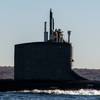Crowley Launches Refurbishment Of 25 Seagoing Tugs
"The long-term investment made in the refurbishment of these tugs is of great benefit to our customers because it helps us to maintain the service reliability and schedule integrity they have come to expect," said Tom Crowley, Jr., Chairman, President and CEO of Crowley Maritime Corporation. To date, five tugs have been refurbished with five scheduled to undergo the process over the next 12 months. The work is being done at North Florida Shipyard in Jacksonville. In addition to the engine refurbishments, a host of other improvements are also being made, including the complete remodeling of interior living spaces and newly designed modular control consoles designed by Crowley's electronics specialists. "Our goal is not just to refurbish the tugs to like-new condition, but to improve their functionality," said Crowley Director of Engineering Mike Golonka. "We have a valuable resource in the crew members and operations personnel who have worked on these tugs during the past 25 years," he said. " Who better to ask about improving the tug's design than the crew who uses it and the operations crew who keep it going?"
Crewmembers were interviewed and operations personnel were asked for input about the tug's' strengths and weaknesses. In addition to giving everyone an important role in the project, the analysis yielded improvements that could be made during the refurbishment. Even minor information that was gathered made a major difference in the overall functionality of the refurbished tug. For example, by adding a small light over the chart table, the Master would no longer have to turn on the overhead light on the bridge-- a problem that previously caused him to lose night visibility.
Stairs and ladder stripping were replaced with a more effective, non-skid coating to reduce the risk of injury. Also, while in the process of rebuilding the interior, Ethernet connections were installed in anticipation of a future LAN system to support PC-based Integrated Vessel Management Solution (IVMS) systems. Dozens of other improvements were made, from trimming interior portholes with stainless steel to prevent water from intruding behind the bulkheads, to replacing wood panels in the cabins and galley with lighter colored, more durable paneling that can be removed easily for access. Even in redesigning the wheelhouse control console in the pilothouse, more room was provided, giving the operator a better vantagepoint during maneuvering and docking operations.











